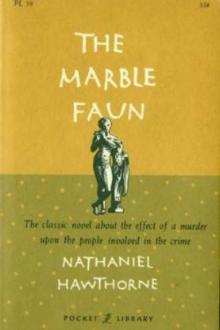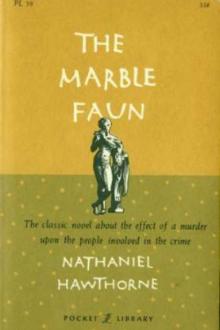The Marble Faun, vol 1 by Nathaniel Hawthorne (best pdf ebook reader for android TXT) 📖

- Author: Nathaniel Hawthorne
- Performer: -
Book online «The Marble Faun, vol 1 by Nathaniel Hawthorne (best pdf ebook reader for android TXT) 📖». Author Nathaniel Hawthorne
“Yes,” said Miriam, who had been revolving some such thoughts as the above, “it is a good state of mind for mortal man, when he is content to leave no more definite memorial than the grass, which will sprout kindly and speedily over his grave, if we do not make the spot barren with marble. Methinks, too, it will be a fresher and better world, when it flings off this great burden of stony memories, which the ages have deemed it a piety to heap upon its back.”
“What you say,” remarked Kenyon, “goes against my whole art. Sculpture, and the delight which men naturally take in it, appear to me a proof that it is good to work with all time before our view.”
“Well, well,” answered Miriam, “I must not quarrel with you for flinging your heavy stones at poor Posterity; and, to say the truth, I think you are as likely to hit the mark as anybody. These busts, now, much as I seem to scorn them, make me feel as if you were a magician.. You turn feverish men into cool, quiet marble. What a blessed change for them! Would you could do as much for me!”
“O, gladly!” cried Kenyon, who had long wished to model that beautiful and most expressive face. “When will you begin to sit?”
“Poh! that was not what I meant,” said Miriam. “Come, show me something else.”
“Do you recognize this?” asked the sculptor.
He took out of his desk a little old-fashioned ivory coffer, yellow with age; it was richly carved with antique figures and foliage; and had Kenyon thought fit to say that Benvenuto Cellini wrought this precious box, the skill and elaborate fancy of the work would by no means have discredited his word, nor the old artist’s fame. At least, it was evidently a production of Benvenuto’s school and century, and might once have been the jewel-case of some grand lady at the court of the De’ Medici.
Lifting the lid, however, no blaze of diamonds was disclosed, but only, lapped in fleecy cotton, a small, beautifully shaped hand, most delicately sculptured in marble. Such loving care and nicest art had been lavished here, that the palm really seemed to have a tenderness in its very substance. Touching those lovely fingers,—had the jealous sculptor allowed you to touch,—you could hardly believe that a virgin warmth would not steal from them into your heart.
“Ah, this is very beautiful!” exclaimed Miriam, with a genial smile. “It is as good in its way as Loulie’s hand with its baby-dimples, which Powers showed me at Florence, evidently valuing it as much as if he had wrought it out of a piece of his great heart. As good as Harriet Hosmer’s clasped hands of Browning and his wife, symbolizing the individuality and heroic union of two high, poetic lives! Nay, I do not question that it is better than either of those, because you must have wrought it passionately, in spite of its maiden palm and dainty fingertips.”
“Then you do recognize it?” asked Kenyon.
“There is but one right hand on earth that could have supplied the model,” answered Miriam; “so small and slender, so perfectly symmetrical, and yet with a character of delicate energy. I have watched it a hundred times at its work; but I did not dream that you had won Hilda so far! How have you persuaded that shy maiden to let you take her hand in marble?”
“Never! She never knew it!” hastily replied Kenyon, anxious to vindicate his mistress’s maidenly reserve. “I stole it from her. The hand is a reminiscence. After gazing at it so often, and even holding it once for an instant, when Hilda was not thinking of me, I should be a bungler indeed, if I could not now reproduce it to something like the life.”
“May you win the original one day!” said Miriam kindly.
“I have little ground to hope it,” answered the sculptor despondingly; “Hilda does not dwell in our mortal atmosphere; and gentle and soft as she appears, it will be as difficult to win her heart as to entice down a white bird from its sunny freedom in the sky. It is strange, with all her delicacy and fragility, the impression she makes of being utterly sufficient to herself. No; I shall never win her. She is abundantly capable of sympathy, and delights to receive it, but she has no need of love.”
“I partly agree with you,” said Miriam. “It is a mistaken idea, which men generally entertain, that nature has made women especially prone to throw their whole being into what is technically called love. We have, to say the least, no more necessity for it than yourselves; only we have nothing else to do with our hearts. When women have other objects in life, they are not apt to fall in love. I can think of many women distinguished in art, literature, and science,—and multitudes whose hearts and minds find good employment in less ostentatious ways,—who lead high, lonely lives, and are conscious of no sacrifice so far as your sex is concerned.”
“And Hilda will be one of these!” said Kenyon sadly; “the thought makes me shiver for myself, and and for her, too.”
“Well,” said Miriam, smiling, “perhaps she may sprain the delicate wrist which you have sculptured to such perfection. In that case you may hope. These old masters to whom she has vowed herself, and whom her slender hand and woman’s heart serve so faithfully, are your only rivals.”
The sculptor sighed as he put away the treasure of Hilda’s marble hand into the ivory coffer, and thought how slight was the possibility that he should ever feel responsive to his own the tender clasp of the original. He dared not even kiss the image that he himself had made: it had assumed its share of Hilda’s remote and shy divinity.
“And now,” said Miriam, “show me the new statue which you asked me hither to see.”
CHAPTER XIV
CLEOPATRA
“My new statue!” said Kenyon, who had positively forgotten it in the thought of Hilda; “here it is, under this veil.” “Not a nude figure, I hope,” observed Miriam. “Every young sculptor seems to think that he must give the world some specimen of indecorous womanhood, and call it Eve, Venus, a Nymph, or any name that may apologize for a lack of decent clothing. I am weary, even more than I am ashamed, of seeing such things. Nowadays people are as good as born in their clothes, and there is practically not a nude human being in existence. An artist, therefore, as you must candidly confess, cannot sculpture nudity with a pure heart, if only because he is compelled to steal guilty glimpses at hired models. The marble inevitably loses its chastity under such circumstances. An old Greek sculptor, no doubt, found his models in the open sunshine, and among pure and princely maidens, and thus the nude statues of antiquity are as modest as violets, and sufficiently draped in their own beauty. But as for Mr. Gibson’s colored Venuses (stained, I believe, with tobacco juice), and all other nudities of to-day, I really do not understand what they have to say to this generation, and would be glad to see as many heaps of quicklime in their stead.”
“You are severe upon the professors of my art,” said Kenyon, half smiling, half seriously; “not that you are wholly wrong, either. We are bound to accept drapery of some kind, and make the best of it. But what are we to do? Must we adopt the costume of to-day, and carve, for example, a Venus in a hoop-petticoat?”
“That would be a boulder, indeed!” rejoined Miriam, laughing. “But the difficulty goes to confirm me in my belief that, except for portrait-busts, sculpture has no longer a right to claim any place among living arts. It has wrought itself out, and come fairly to an end. There is never a new group nowadays; never even so much as a new attitude. Greenough (I take my examples among men of merit) imagined nothing new; nor Crawford either, except in the tailoring line. There are not, as you will own, more than half a dozen positively original statues or groups in the world, and these few are of immemorial antiquity. A person familiar with the Vatican, the Uffizzi Gallery, the Naples Gallery, and the Louvre, will at once refer any modern production to its antique prototype; which, moreover, had begun to get out of fashion, even in old Roman days.”
“Pray stop, Miriam,” cried Kenyon, “or I shall fling away the chisel forever!”
“Fairly own to me, then, my friend,” rejoined Miriam, whose disturbed mind found a certain relief in this declamation, “that you sculptors are, of necessity, the greatest plagiarists in the world.”
“I do not own it,” said Kenyon, “yet cannot utterly contradict you, as regards the actual state of the art. But as long as the Carrara quarries still yield pure blocks, and while my own country has marble mountains, probably as fine in quality, I shall steadfastly believe that future sculptors will revive this noblest of the beautiful arts, and people the world with new shapes of delicate grace and massive grandeur. Perhaps,” he added, smiling, “mankind will consent to wear a more manageable costume; or, at worst, we sculptors shall get the skill to make broadcloth transparent, and render a majestic human character visible through the coats and trousers of the present day.”
“Be it so!” said Miriam; “you are past my counsel. Show me the veiled figure, which, I am afraid, I have criticised beforehand. To make amends, I am in the mood to praise it now.”
But, as Kenyon was about to take the cloth off the clay model, she laid her hand on his arm.
“Tell me first what is the subject,” said she, “for I have sometimes incurred great displeasure from members of your brotherhood by being too obtuse to puzzle out the purport of their productions. It is so difficult, you know, to compress and define a character or story, and make it patent at a glance, within the narrow scope attainable by sculpture! Indeed, I fancy it is still the ordinary habit with sculptors, first to finish their group of statuary,—in such development as the particular block of marble will allow,—and then to choose the subject; as John of Bologna did with his Rape of the Sabines. Have you followed that good example?”
“No; my statue is intended for Cleopatra,” replied Kenyon, a little disturbed by Miriam’s raillery. “The special epoch of her history you must make out for yourself.”
He drew away the cloth that had served to keep the moisture of the clay model from being exhaled. The sitting figure of a woman was seen. She was draped from head to foot in a costume minutely and scrupulously studied from that of ancient Egypt, as revealed by the strange sculpture of that country, its coins, drawings, painted mummy-cases, and whatever other tokens have been dug
 Reading books romantic stories you will plunge into the world of feelings and love. Most of the time the story ends happily. Very interesting and informative to read books historical romance novels to feel the atmosphere of that time.
Reading books romantic stories you will plunge into the world of feelings and love. Most of the time the story ends happily. Very interesting and informative to read books historical romance novels to feel the atmosphere of that time.




Comments (0)